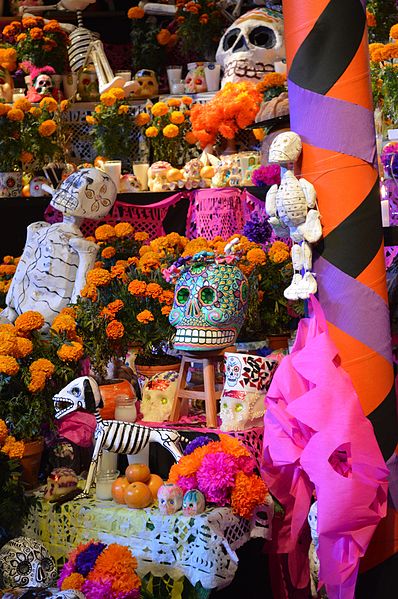The Day of the Dead is a holiday traditionally celebrated on November 1 and 2, though other days, such as October 31 or November 6, may be included depending on the locality. It is widely observed in Mexico, where it largely developed, and is also observed in other places, especially by people of Mexican heritage. The observance falls during the Christian period of Allhallowtide. Some argue that there are Indigenous Mexican or ancient Aztec influences that account for the custom, and it has become a way to remember those forebears of Mexican culture. The Day of the Dead is largely seen as having a festive characteristic. The multi-day holiday involves family and friends gathering to pay respects and to remember friends and family members who have died. These celebrations can take a humorous tone, as celebrants remember funny events and anecdotes about the departed.
Día de Muertos altar commemorating a deceased man in Milpa Alta, Mexico City
Mexican cempasúchil (marigold) is the traditional flower used to honor the dead.
Cempasúchil, alfeñiques and papel picado used to decorate an altar
Families tidying and decorating graves at a cemetery in Almoloya del Río in the State of Mexico, 1995
Allhallowtide, Hallowtide, Allsaintstide, or the Hallowmas season is the Western Christian season encompassing the triduum of All Saints' Eve (Halloween), All Saints' Day and All Souls' Day, as well as the International Day of Prayer for the Persecuted Church and Remembrance Sunday in some traditions. The period begins on 31 October annually. Allhallowtide is a "time to remember the dead, including martyrs, saints, and all faithful departed Christians." The present date of Hallowmas and thus also of its vigil (Hallowe'en) was established for Rome perhaps by Pope Gregory III (731–741) and was made of obligation throughout the Frankish Empire by Louis the Pious in 835. Elsewhere, other dates were observed even later, with the date in Ireland being 20 April. In the early 11th century, the modern date of All Souls' Day was popularized, after Abbot Odilo established it as a day for the monks of Cluny and associated monasteries to pray for the dead.

The Church Militant and the Church Triumphant, fresco by Andrea da Firenze in Santa Maria Novella, c. A.D. 1365
Many of the remains of the martyrs of the ancient Church lie in the catacombs
Hallowe'en decorations in Eifeler Hof, Germany.
A cemetery outside an Evangelical Lutheran church (Church of Sweden) in Röke, Sweden on the feast of All Hallows. Flowers and lighted candles are placed by relatives on the graves of their deceased loved ones.








